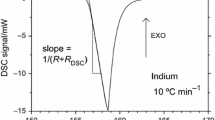Abstract
When gases evolve during a chemical reaction, a fraction of the reaction heat is lost with them. We have analyzed, both theoretically and experimentally, the deviations that this effect can produce on the determination of the reaction heat by differential scanning calorimetry (DSC). It is shown that, even in the absence of gas overheating, deviations related to variations in the sample heat capacity can be substantial in experiments involving very intense DSC peaks. However, experiments performed on thermal decomposition of metal organic salts and on evaporation of liquids have shown that deviations usually arise from gas overheating.







Similar content being viewed by others
Abbreviations
- α :
-
Transformed fraction
- β :
-
Heating rate of the reference temperature
- C :
-
Heat capacity of the sample placed inside the pan
- C A, C B :
-
Heat capacity of the solid sample at the beginning and at the end of the reaction
- C G :
-
Heat capacity of the evolved gas
- c pS, c pL, c pG :
-
Specific heat capacity (per unit mass) at constant pressure of solid, liquid and gas
- C REF :
-
Pan heat capacity
- DSCP :
-
DSC value after baseline subtraction
- ΔH :
-
Enthalpy of reaction
- ΔT G :
-
Gas overheating above T S
- ΔQ C, ΔQ G, ΔQ P :
-
Corrections to the measured heat due to gas evolution (see main text)
- L BOIL :
-
Latent heat of boiling
- L EV :
-
Latent heat of evaporation
- m :
-
Mass of the sample remaining inside the pan
- Q :
-
DSC peak area (after baseline subtraction)
- \( \dot{q}_{{}} \) :
-
Heat power exchanged due to a chemical reaction \( \left( {\Delta H = - \int {\dot{q}} \,{\text{d}}t} \right) \)
- \( \dot{Q}_{\text{REF}} \) :
-
Heat power flowing through the “sample” side of the DSC sensor
- \( \dot{Q}_{\text{S}} \) :
-
Idem through the “reference” side
- R :
-
Thermal resistance of the DSC sensor
- T BOIL :
-
Boiling point
- T REF :
-
Temperature at the “reference” side of the DSC sensor
- T S :
-
Temperature at the “sample” side of the DSC sensor
- τ SIGNAL :
-
Time constant characteristic of the DSC signal
References
Zemansky MW, Dittman RH. Heat and thermodynamics, Ch. 10. 6th ed. New York: McGraw-Hill; 1981.
Sanchez-Rodriguez D, Farjas J, Roura P, Ricart S, Mestres N, Obradors X, Puig T. Thermal analysis for low temperature synthesis of oxide thin films from chemical solutions. J Phys Chem C. 2013;117:20133–8.
HöhneGWH Hemminger W, Flammersheim H-J. Differential scanning calorimetry: an introduction for practitioners. Berlin: Springer-Verlag; 1996.
Sanchez-Rodriguez D, Eloussifi H, Farjas J, Roura P, Dammak M. Thermal gradients in thermal analysis experiments: criterions to prevent inaccuracies when determining sample temperature and kinetic parameters. Thermochim Acta. 2014;589:37–46.
Roduit B, Xia L, Folly P, Berger B, Mathieu J, Sarbach A, Andres H, Ramin M, Vogelsanger B, Spitzer D, Moulard H, Dilhan D. The simulation of the thermal behavior of energetic materials based on DSC and HFC signals. J Therm Anal Calorim. 2008;93:143–52.
Schwartz R, Schneller T, Waser R. Chemical solution deposition of electronic oxide films. C. R. Chimie. 2004;7:433–61.
Roura P, Farjas J, Camps J, Ricart S, Arbiol J, Puig T, Obradors X. Decomposition processes and structural transformations of cerium propionate into nanocrystalline ceria at different oxygen partial pressures. J Nanopart Res. 2011;13:4085–96.
Eloussifi H, Farjas J, Roura P, Camps J, Dammak M, Ricart S, Puig T, Obradors X. Evolution of Yttrium trifluoroacetate during thermal decomposition. J Therm Anal Calorim. 2012;108:589–96.
Farjas J, Camps J, Roura P, Ricart S, Puig T, Obradors X. The thermal decomposition of barium trifluoroacetate. Thermochim Acta. 2012;544:77–83.
Butrow AB, Seyler RJ. Vapor pressure by DSC: extending ASTM E 1782 below 5 kPa. Thermochim Acta. 2003;402:145–52.
Contreras MD, Girela F, Parera A. The perfection of a method for the determination of the temperature vapor-pressure function of liquids by differential scanning calorimetry. Thermochim Acta. 1993;219:167–72.
Cedeño FO, Prieto MM, Espina A, Garcia JR. Fast method for the experimental determination of vaporization enthalpy by differential scanning calorimetry. J Therm Anal Calorim. 2003;73:775–81.
Acknowledgements
This work was partially funded by the Spanish Programa Nacional de Materiales through projects MAT2011-28874-C02-02 and by the Generalitat de Catalunya contract No. 2009SGR-185. The authors thank the University of Girona for the PhD fellowship granted to Daniel Sánchez-Rodríguez and for the use of the thermal analysis facilities (Serveis Tècnics de Recerca).
Author information
Authors and Affiliations
Corresponding author
Appendix
Appendix
Calculation of ΔQ P and ΔQ C
We need to calculate the third term on the right-hand side of Eq. 10:
Integration by parts and substitution of C by its value of Eq. 5 leads to:
where “i” and “f” refer to the value before and after the DSC peak. ΔQ C is the addition of the first two terms. If we take into account that
and consider that, usually,
we arrive to the desired result:
where R(C REF + C A) is the DSC time constant τ SIGNAL [3] at the beginning of the reaction. For reactions involving gas evolution, R (C REF + C A) > τ SIGNAL.
The last term in Eq. 19 is ΔQ P. In general, α can be obtained from a TG curve (Eq. 6). In those cases where the time response of the DSC signal is short enough, use of Eq. 7 leads to the desired result:
Rights and permissions
About this article
Cite this article
García, E., Sánchez-Rodríguez, D., López-Olmedo, J.P. et al. The effect of volatiles on the measurement of the reaction heat by differential scanning calorimetry. J Therm Anal Calorim 121, 187–194 (2015). https://doi.org/10.1007/s10973-015-4465-8
Received:
Accepted:
Published:
Issue Date:
DOI: https://doi.org/10.1007/s10973-015-4465-8




